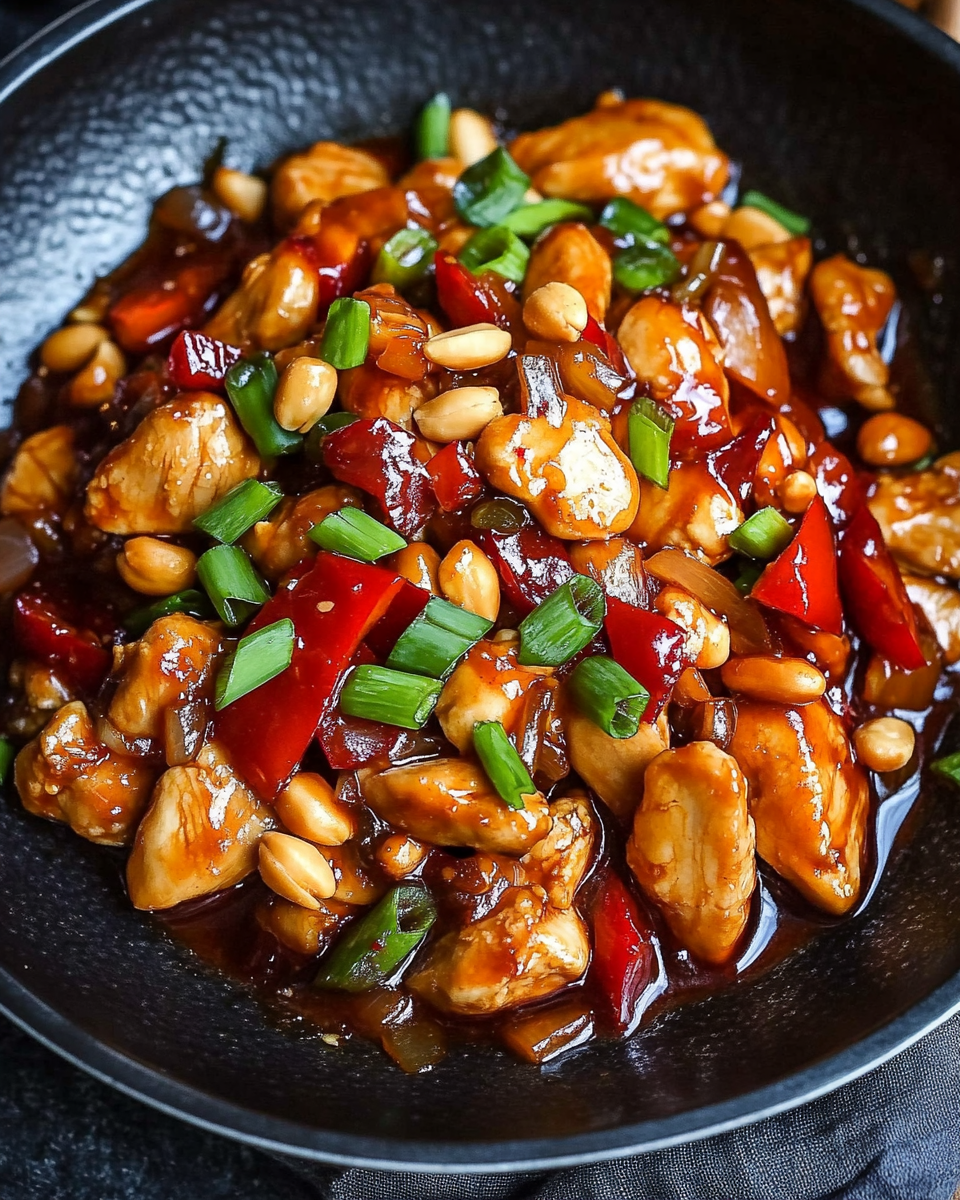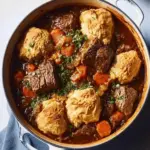Kung Pao Chicken is a beloved Chinese stir-fry dish known for its vibrant flavors and a fiery kick. With tender chicken, roasted peanuts, and bell peppers, this dish combines salty, sweet, sour, and spicy elements into a perfect harmony. It’s a quick and easy recipe that can be customized to your spice preference, making it a great weeknight meal. This recipe takes just 30 minutes, so you can enjoy a restaurant-quality dish at home with minimal effort!
Full Recipe:
Ingredients
For the Chicken & Marinade:
-
300g boneless, skinless chicken breasts, cut into bite-sized pieces
-
1 tsp light soy sauce
-
½ tsp white pepper
-
1 tsp cornstarch
For the Kung Pao Sauce:
-
1 tbsp light soy sauce
-
1 tbsp dark soy sauce
-
1 tbsp oyster sauce
-
1 tbsp vinegar (apple cider vinegar or rice vinegar)
-
1 tsp sugar
-
1 cup water
-
1 tsp cornstarch
For the Stir Fry:
-
4-5 dried chili peppers, cut and deseeded
-
1 tbsp peanuts (raw or roasted)
-
2 tbsp vegetable oil
-
2 cloves garlic, minced
-
1-inch piece of ginger, julienned
-
½ onion, sliced
-
½ tsp ground Sichuan peppercorns (optional)
-
Spring onions for garnish
Directions
-
Marinate the chicken:
In a bowl, combine the chicken with light soy sauce, white pepper, and cornstarch. Mix well and let it marinate for 20 minutes (overnight is preferable for deeper flavor). -
Prepare the sauce:
In a separate bowl, whisk together light soy sauce, dark soy sauce, oyster sauce, vinegar, sugar, water, and cornstarch. Set it aside. -
Toast the chilies and peanuts:
Heat a dry pan over medium heat and add the dried chilies and peanuts. Stir until they become fragrant and slightly charred. Remove from the pan and set aside. -
Cook the chicken:
In the same pan, add vegetable oil and heat it up. Add the marinated chicken and stir-fry until cooked through and lightly browned. -
Add aromatics and chilies:
Add garlic, ginger, and onions to the pan, and stir-fry for 1-2 minutes. Then, return the toasted chilies and peanuts to the pan. Stir everything together. -
Add the sauce:
Pour the prepared sauce mixture into the pan and add ground Sichuan peppercorns (if using). Stir-fry for a few more minutes until the sauce thickens and coats everything evenly. -
Serve:
Remove from heat and garnish with sliced spring onions. Serve hot with steamed rice.
Nutrients (Per Serving)
-
Calories: 400-450 kcal
-
Protein: 32g
-
Fat: 25g
-
Saturated Fat: 3g
-
-
Carbohydrates: 12g
-
Fiber: 2g
-
Sugar: 8g
-
-
Sodium: 900mg
The Origins of Kung Pao Chicken
Kung Pao Chicken, also known as “Gong Bao” or “Kung Po,” has a rich history dating back to the Qing Dynasty in China. The dish was named after Ding Baozhen, a Qing Dynasty official whose title, “Kung Pao,” roughly translates to “Palace Guardian.” It is believed that the dish originated from Sichuan Province, which is renowned for its bold and spicy cuisine. Over time, the dish became popular in various regions of China and eventually made its way to international kitchens, where it became a staple on Chinese restaurant menus worldwide.
Kung Pao Chicken is one of the most iconic stir-fry dishes in Chinese cuisine, and while it has evolved over the years, its core elements—chicken, peanuts, and a spicy, savory sauce—remain unchanged. The dish continues to be a beloved choice for its versatility, ease of preparation, and irresistible combination of flavors.
Key Ingredients and Flavor Profile
The magic of Kung Pao Chicken lies in the balance of its key ingredients, which come together to create a symphony of flavors. The chicken is the focal point, and it is typically marinated in a mixture of soy sauce, white pepper, and cornstarch to tenderize it and allow it to absorb the savory flavors of the sauce. Once cooked, the chicken takes on a slightly crispy texture that contrasts beautifully with the crunchy peanuts and soft vegetables.
The sauce for Kung Pao Chicken is the true hero of the dish. The combination of light and dark soy sauces provides a rich, salty base, while the oyster sauce adds depth and umami. A touch of sugar balances the saltiness, and vinegar adds acidity and tang, cutting through the richness of the sauce. The cornstarch in the sauce thickens it, creating a glossy, velvety coating that perfectly coats the chicken and vegetables.
Sichuan peppercorns are a traditional ingredient in Kung Pao Chicken and lend a unique numbing heat to the dish. This ingredient is what sets Kung Pao Chicken apart from other stir-fries, as it gives the dish an unmistakable flavor and heat that is characteristic of Sichuan cuisine. The addition of dried chilies introduces a smoky heat, while the peanuts provide crunch and a nutty sweetness, rounding out the dish’s complex flavor profile.
The Versatility of Kung Pao Chicken
One of the reasons Kung Pao Chicken has remained a popular dish for so long is its versatility. The base ingredients—chicken, peanuts, and vegetables—can be adapted to suit different preferences and dietary needs. For instance, if you’re looking for a vegetarian version, you can easily replace the chicken with tofu or tempeh, which will absorb the same flavorful sauce and provide a similar texture. You can also add a variety of vegetables, such as carrots, mushrooms, or zucchini, to enhance the dish and add more color and nutrients.
For those who love heat, the amount of dried chili peppers can be adjusted to increase the spiciness, or you can add chili paste for an extra punch. Conversely, if you’re looking for a milder version, you can reduce the chili peppers and omit the Sichuan peppercorns for a less intense level of heat. The beauty of Kung Pao Chicken is that it can be customized to your taste, allowing for endless variations while maintaining the essence of the dish.
Cooking Technique: Stir-Frying for Perfect Texture
Stir-frying is the cooking technique used to make Kung Pao Chicken, and it’s what gives the dish its signature texture and flavor. Stir-frying over high heat allows the chicken to cook quickly, searing the exterior while keeping the interior juicy and tender. The vegetables, including bell peppers and onions, are cooked just long enough to soften slightly while retaining their crisp texture, providing a contrast to the tender chicken.
The key to successful stir-frying is ensuring that all the ingredients are cooked evenly and that the sauce is well-distributed. The use of a wok or large skillet helps to evenly cook the ingredients, while allowing them to sear and brown, creating layers of flavor. The high heat also helps the sauce to thicken and coat the chicken and vegetables, creating a glossy finish that makes the dish visually appealing and incredibly flavorful.
Serving Kung Pao Chicken
Kung Pao Chicken is typically served with steamed rice, which helps to absorb the flavorful sauce and balance out the dish’s spiciness. The rice provides a neutral base that complements the savory, tangy sauce, while also adding a soft texture that contrasts with the crispy chicken and crunchy peanuts. Alternatively, Kung Pao Chicken can also be served with noodles for a more substantial meal.
For a lighter option, you can serve the dish over cauliflower rice or spiralized vegetables, such as zucchini noodles, for a low-carb version. The rich, flavorful sauce will still pair beautifully with these alternatives, allowing you to enjoy the essence of Kung Pao Chicken without the added carbs.
The dish can also be garnished with sliced spring onions and additional roasted peanuts for extra crunch and freshness. A sprinkle of sesame seeds adds a subtle nutty flavor and an extra layer of texture, making the dish even more visually appealing.
Health Benefits of Kung Pao Chicken
While Kung Pao Chicken is typically enjoyed as a savory indulgence, it also offers some nutritional benefits. The chicken provides a high-quality source of protein, which is essential for muscle repair, immune function, and overall body health. The peanuts, a key ingredient in the dish, are rich in healthy fats, fiber, and protein, making them a great source of energy and nutrition.
The bell peppers and onions add a variety of vitamins and minerals, including vitamin C, which supports immune health, and fiber, which aids in digestion. The vinegar in the sauce adds a small amount of antioxidants, while the addition of garlic and ginger provides anti-inflammatory properties, further boosting the dish’s nutritional profile.
Although Kung Pao Chicken is a flavorful dish, it’s also relatively low in carbohydrates, making it suitable for those following low-carb or keto diets. The use of healthy oils and the ability to control the level of sweetness in the sauce means that the dish can be tailored to suit different dietary needs.
Conclusion: A Flavor-Packed, Quick Weeknight Meal
In conclusion, Kung Pao Chicken is a delicious, quick, and versatile dish that delivers bold, vibrant flavors in every bite. The combination of tender chicken, crunchy peanuts, and colorful vegetables, all coated in a savory, sweet, sour, and spicy sauce, makes this dish a standout choice for any meal. Whether you’re cooking for a family dinner or preparing a meal for yourself, Kung Pao Chicken is easy to make in just 30 minutes, and it offers a restaurant-quality experience at home. The balance of flavors and textures, along with the ability to customize the spice level, makes it a dish that will satisfy a variety of tastes. Whether served over rice, noodles, or cauliflower rice, Kung Pao Chicken is a fulfilling and flavorful meal that can be enjoyed by everyone.






